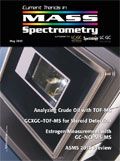58th ASMS Conference Preview
Associate Editor Meg Evans previews the upcoming ASMS conference, taking place May 23–27, 2010 in Salt Lake City, Utah.
As one of the most popular conferences in the spectroscopy community, the 58th Annual ASMS Conference on Mass Spectrometry and Allied Topics is sure to be a hit once again this year. The conference will be held at the Salt Palace Convention Center, 100 S. West Temple, Salt Lake City, Utah, May 23–27, 2010. All oral sessions, poster sessions, and exhibit booths will be located in the Convention Center.

For those getting to Salt Lake City a day early, there are a few short courses offered on Saturday, May 22, and conference registration will be open from 2:00 to 5:00 p.m. The program is officially scheduled to being on Sunday, May 23, with short courses from 9:00 a.m to 4:30 p.m, conference registration from 10:00 a.m. to 8:00 p.m, and tutorial lectures from 5:00 to 6:30 p.m. The tutorial lectures, given by Peter B. Armentrout (University of Utah) and Walter A. Korfmacher (Merck Research Laboratories) will discuss important topics such as how collision-induced dissociation works and mass spectrometry in drug discovery and development. These will be followed by the opening session and plenary lecture from 6:45 to 7:45 p.m. This year's plenary lecturer is Dr. Leroy Hood from the Institute for Systems Biology. Dr. Hood's research has focused on the study of molecular immunology, biotechnology, and genomics, all of which will make for a very interesting lecture. Closing out the evening will be the welcome reception from 7:45 to 9:30 p.m.
Program Schedule
Monday through Thursday will be full program days consisting of oral sessions, poster sessions, workshops, and, last but certainly not least, corporate hospitality suites. Oral sessions are broken up into morning and afternoon groups, with the morning running from 8:30 to 10:30 a.m daily and the afternoon running from 2:30 to 4:30 p.m daily. Poster sessions, exhibits, and lunch breaks are grouped together from 10:30 a.m to 2:30 p.m., so plan meals accordingly.

There are many interesting oral and poster sessions (too many to list completely), but here are a few that might pique some interest. On Monday: "MS Derived Peptide/Protein Biosignatures/Biomarkers," "Application of LC–MS for PK Characteristics of Biologics," "MS of Synthetic Polymers," "LC–MS Challenges/Solutions for Monitoring of Human Metabolites in Safety Test (MIST)," and "MS of Glycoprotein I." On Tuesday: "Mass Spectrometry of Protein-Ligand Complexes," "Identification of Unusual Xenobiotic Metabolites Using Mass Spectrometry," "MS of Glycoprotein II," and "Environmental Analysis: Pharmaceuticals & Pesticides." On Wednesday: "Clinical Applications of Integrated Qualitative and Quantitative LC–MS," "MS of Pharmaceuticals and Personal Care Products in Water," "GC–MS Developments and Applications," and "Imaging MS: Biomolecules." On Thursday: "Electron and Photon-Based Ion Activation/Dissociation-PD, ECD, ETD, EDD," "Recent Developments in Ion Mobility MS," and "Imaging MS: Small Molecules."
Workshops and Interest Group Meetings
Workshops and interest group meetings will be held Monday to Wednesday from 5:45 to 7:00 p.m. daily. Workshops and interest groups are open to all as a forum for discussion, with no additional charge.
Topics include: "Identification of Unique Metabolites: New MS Techniques and Strategies," "The Role of Mass Spectrometry in Our Future Energy Supply," "LC/MS/MS Analysis of Biomarkers and their Impact on Drug Development," "Careers of Young Mass Spectrometrists," "Towards an Automated Mass Spec Analyzer for Clinical Labs - What, When and How?" and "The Great Dissociation Debate. What's Your Favorite Way to Dissociate Ions Inside an Ion Trap?"
Awards
There will be two awards presented at this year's conference: the award for a Distinguished Contribution in Mass Spectrometry and the Biemann Medal. The award for a Distinguished Contribution in Mass Spectrometry will be presented on Monday, May 24, during the plenary lecture scheduled for 4:30-5:45 p.m. The Biemann Medal will be given on Tuesday, May 25, during the plenary lecture scheduled for 4:30–5:45 p.m. The award recipients have not been announced yet, so be sure to attend this event to find out who is being honored this year.
Conference Finale
The conference will conclude on Thursday evening, May 27, with a plenary lecture from 4:45 to 5:30 p.m. given by Svante Pääbo of the Max Planck Institute for Evolutionary Anthropology. Following the lecture, there will be a closing toast.
Plan Your Visit to Salt Lake City
Here is some general information on getting to and around Salt Lake City. Taxi fare from the airport to downtown hotels is approximately $20. A UTA bus leaves the airport for the City Center every 30 minutes during the day and every 60 minutes after 7:00 p.m. — one-way fare is $1.60. Bus stops are located in the parking structure between Terminal One and Terminal Two. Limited service is available on weekends and holidays. The largest hotel is Little America, which provides resort-style amenities in addition to very nice accommodations. ASMS will provide shuttle buses to the Little and Grand America hotels. Also, the Salt Lake City Light Rail is convenient and free transportation from these hotels.
Salt Lake City also offers several fun attractions if you find yourself with some free time. One of the main attractions is the Great Salt Lake, which has an area of 20,000 square miles, is the second saltiest lake in the world, and includes a wildlife refuge attracting millions of migratory birds every year. Another tourist spot is historic Mormon Temple Square, which features the Mormon pioneer history and genealogy, including the Salt Lake Temple, the Tabernacle, and the Family History Library. Salt Lake City was also home to the 2002 Winter Olympics and visitors are welcome to stop by Utah Olympic Park, Soldier Hollow, and Utah Olympic Oval for a variety of activities. The Olympic parks are open year-round.
Registration and Further Information
Advance conference registration fees are $150 for ASMS members, $300 for nonmembers, $75 for ASMS students, and $120 for student nonmembers. One-day registration is available on-site and for one day only. It is $175 and includes a printed program, but no conference proceedings on DVD and no access to web casting.
The deadline for advance conference registration is April 26, 2010. Those who have not registered by April 26 may register on-site at the convention center beginning Saturday, May 22, 2:00–5:00 p.m., Sunday, May 23, 10:00 a.m.–8:00 p.m., and Monday through Thursday 7:30 a.m–5:00 p.m. An additional $50 will be charged for on-site registration.
For further information about the conference please contact: ASMS, 2019 Galisteo Street, Building I-1, Santa Fe, NM 87505, Tel. (505)989-4517, fax (505)989-1073, Email: office@asms.org, Website: www.asms.org.

New TRC Facility Accelerates Innovation and Delivery
April 25th 2025We’ve expanded our capabilities with a state-of-the-art, 200,000 sq ft TRC facility in Toronto, completed in 2024 and staffed by over 100 PhD- and MSc-level scientists. This investment enables the development of more innovative compounds, a broader catalogue and custom offering, and streamlined operations for faster delivery. • Our extensive range of over 100,000 high-quality research chemicals—including APIs, metabolites, and impurities in both native and stable isotope-labelled forms—provides essential tools for uncovering molecular disease mechanisms and exploring new opportunities for therapeutic intervention.
New Guide: Characterising Impurity Standards – What Defines “Good Enough?”
April 25th 2025Impurity reference standards (IRSs) are essential for accurately identifying and quantifying impurities in pharmaceutical development and manufacturing. Yet, with limited regulatory guidance on how much characterisation is truly required for different applications, selecting the right standard can be challenging. To help, LGC has developed a new interactive multimedia guide, packed with expert insights to support your decision-making and give you greater confidence when choosing the right IRS for your specific needs.

.png&w=3840&q=75)

.png&w=3840&q=75)



.png&w=3840&q=75)



.png&w=3840&q=75)










